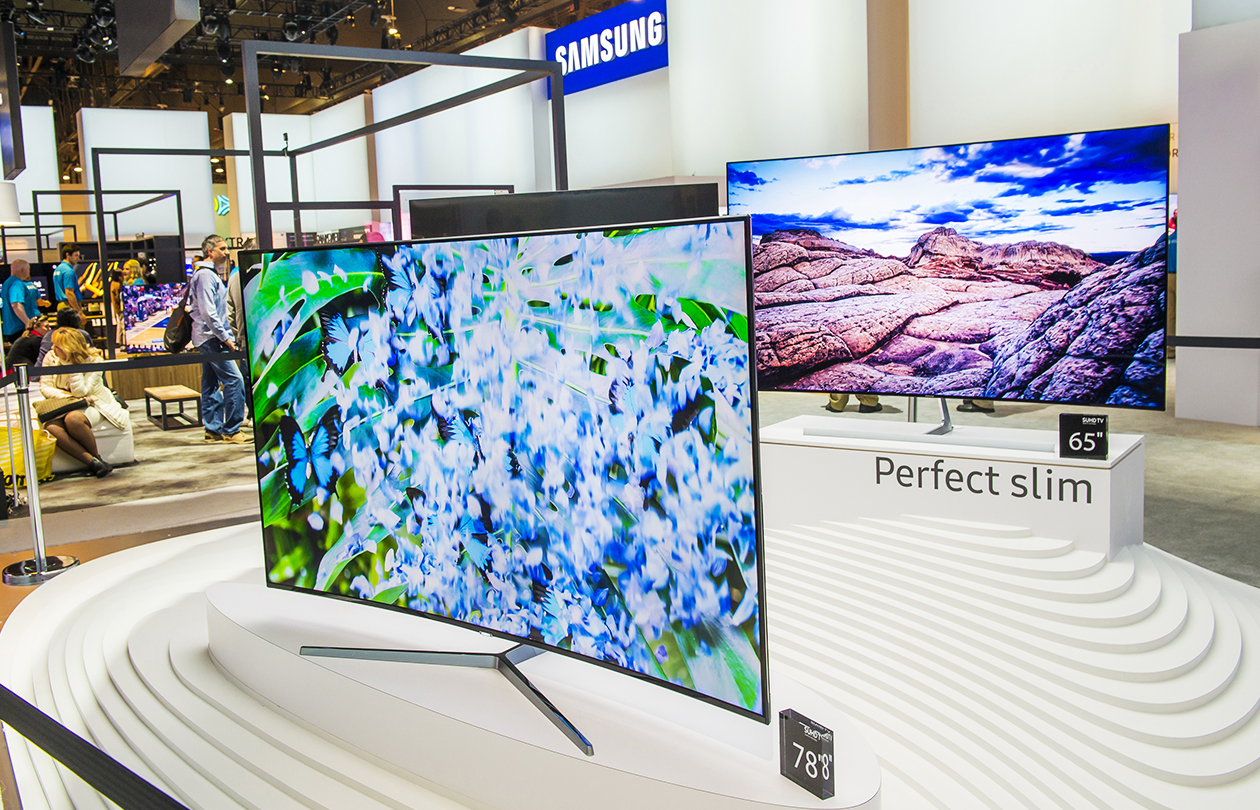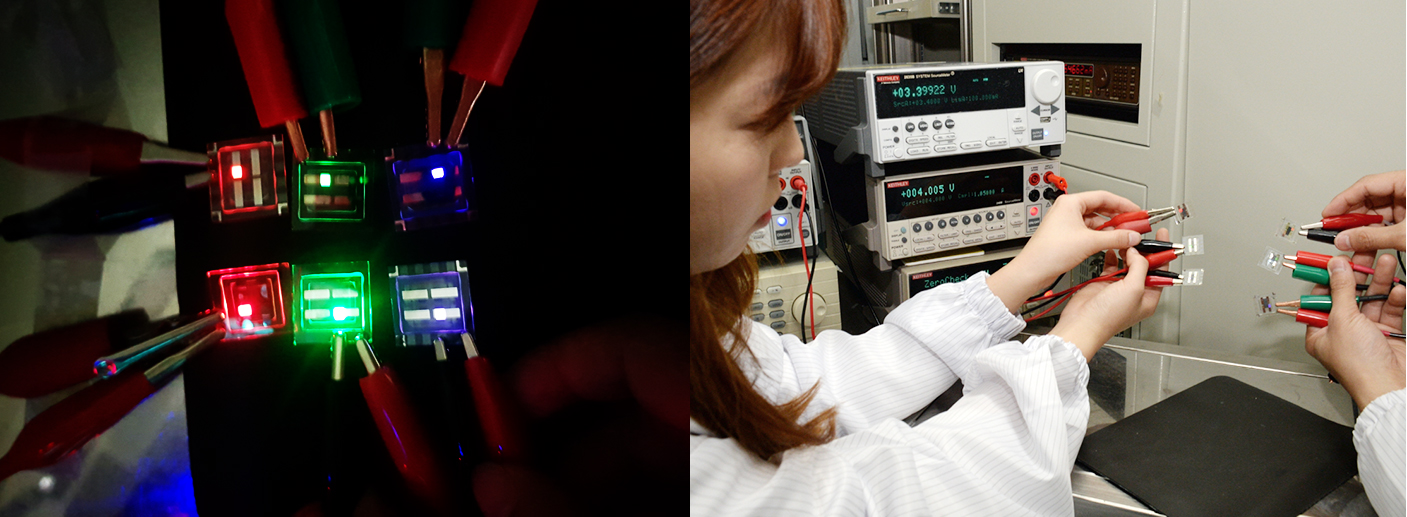VOL.53
June 2019


Special ____ Future Display Technology to be Implemented by QLED
Future Display Technology to be Implemented by QLED
Display technology serves as a medium to deliver visual information to people. As can be expected, display producers are fiercely competing against each other in the market, especially for high-definition display products. This is also the case in the R&D sector. Currently, the industry and scientific circles are actively preparing for the era of next-generation display solutions, which will end up replacing OLED technology. Here, let us guide you through QLED, a next-generation display technology that provides excellent color reproduction performance and efficiency and can be implemented in various shapes.


Ever-continuing Evolution of Display Technology
The Cathode Ray Tube (CRT), developed in 1897 by the German physicist Ferdinand Braun, has been used as a primary means of display for over a century. In the CRT, thermoelectrons emitted from the cathode of an electron gun are deflected through the inside of the electron gun onto the screen. The electron beam then collides with fluorescent materials, and phosphors emitted therefrom are displayed on the screen. With its low price and high resolution, the CRT had been widely used before the emergence of flat-panel display technology. However, CRT display products are typically large in volume and, the larger the screen is, the thicker it becomes. Also, with the rapidly growing trend toward larger and slimmer display products, the technology started to lose ground.
In the 2000s, Liquid Crystal Display (LCD) technology emerged and started to dominate the display market. The molecular arrangement of the LCD, one of the most distinctive properties of a liquid crystal, makes it possible to produce large but still very thin displays. With this advantage, the technology has been extensively used in various electronic appliances, such as smartphones, monitors, TVs, and laptops. Meanwhile, the evolution of display technology has consistently continued with the development of new display solutions, such as Light Emitting Diode (LED) and Organic Light Emitting Diode (OLED) technologies. Notably, due to its various attractive advantages, OLED, among others, has become a core display technology, with its scope of application extended to various display fields.
OLED falls into the category of self-illuminating displays in which light is generated using organic materials that self-illuminate when a current flows through them. Its operating mechanism differs from that of LCD, in which light is supplied through the backlight unit. For that reason, the OLED manufacturing process is simpler than that of LCD. Also, OLED products are lighter and thinner while providing a higher definition (e.g., in terms of color expression and contrast range), along with lower power consumption. OLED devices are flexible and thus highly suitable for design and form-factor innovation. However, OLED material costs are higher compared to LCD and LED, and thus OLED display devices are more expensive. Also, the required deposition process makes it difficult to produce large displays. In large-size applications, display panels can bend, and their material characteristics can easily change when exposed to moisture or oxygen. Furthermore, when used for a long period of time, the products can be exposed to the burn-in phenomenon. All things considered, there is growing demand for the development of new display material. One of the leading candidates that will replace OLED as next-generation display technology is Quantum dot Light-Emitting Diodes (QLED).
Form Factor
It refers to the size, configuration, and physical arrangement of computer hardware. It is typically used to indicate the size and arrangement of the internal components of a computer, such as the case, chassis, and daughterboard (DB).
Burn-in
It refers to a phenomenon in which colors are not properly displayed for part of the image shown in the display, or afterimages and stains occur when the display is left at a standstill for a long period of time, or the same images are repeated.

QLED Emerging as Next-generation Display Technology
OLED uses organic materials while QLED uses semiconductors, i.e., quantum dots. Recently, there has been growing demand for display technologies capable of faithfully reproducing nature’s colors, and thus OLED technology has been receiving growing attention due to its ability to provide the widest range of colors.
A good example of a QLED TV was released by Samsung Electronics in 2016. Strictly speaking, however, the QLED TV released at that time was just an upgraded version of the LCD TV. In the LCD TV, light emitted from the backlight light source goes through the pixels and then filters of the three primary colors, i.e., red, green, and blue, in cellophane, display various colors. In the QLED TV, a quantum dot film is placed in front of the backlight to improve the color reproduction performance of light, and the light then goes through the color filters to display colors of high purity. The QLED TV, however, has intrinsic limitations, such as in the viewing angle and contrast range. As it stands, the application of a quantum dot film is nothing more than a stopgap, and the structural limitations of LCT TV still remain unsolved.
The most difficult problem involved in QLED technology is the imbalance in the movement of electrons and holes in the emission material layer. In a QLED display device, light is generated at quantum dots where electrons and holes injected from the two electrodes meet. However, unlike electrons, which tend to move freely up and down, holes are difficult to move because the concerned energy transfer between the electrodes and the quantum dots is slow. This electron-hole imbalance degrades the performance of the QLED and thus reduces the lifecycle of QLED devices. This is why more research is needed.

A QLED developed by ETRI researchers, which is shining brighter than the existing QLED under the same voltage condition / A device developed by ETRI researchers, which displays red, green, and blue colors when electrodes are applied
Future to be Reproduced by QLED
In the domestic display market, research is actively underway on quantum dot-based display solutions, i.e., QLED devices. It is worth noting that Korea is a leading player in the global LED market as well. For example, in 2013, eco-friendly QLED display technology capable of reproducing each and every color in nature was developed by a research team led by Char, Kook Heon, a professor at Seoul National University, drawing significant attention from the world. The invention, however, had a limitation in that its commercialization is difficult because cadmium, a harmful heavy metal, needed to be used. In response, Char’s research team introduced a new approach in which electrons and holes are directly injected into the inside of colloidal quantum dots and combined there to generate light.
Meanwhile, in 2015, the Center for Nanoparticle Research of the Institute for Basic Science (IBS) developed a skin-attached OLED device that provides a resolution four times as high as that of the latest smartphones but is only one-fortieth as thick as a human hair. This QLED display is a 2.6-㎛ thick ultra-thin film device that can be bent and stretched as desired. Because it operates at a low voltage, device can be used while attached to human skin.
On April 16, ETRI announced its development of core QLED technology that can improve the brightness and current & power efficiency of QLEDs based on improved hole injection technology in which the molecular sieves that constitute the surface of the quantum dots are modified. The invented technology can implement a QLED whose brightness is up to 4.5 times larger, current efficiency is 1.7 times higher, and power efficiency is 2.3 times higher than those of existing devices. Also, the technology can be applied in the same way to all quantum dots of any RGB color, i.e., red, green, and blue, and thus it is expected to make an important contribution to the commercialization of QLED technology. Going forward, the technology is expected to be used in various fields and applications, such as ultra-high resolution Head Mounted Displays (HMDs) for VR and AR applications, near-eye displays, and implantable optically stimulated light sources for biostimulation and bio-inhibition. Simply put, there is a bright market outlook for the technology.
Competition to develop QLED TVs is fierce not only in scientific circles but also among domestic companies. The reason for such significant attention to QLED technology is to widen the technology gap with the Chinese electronics companies that are rapidly catching up. In this regard, now is the time to further advance QLED technology. Hyunku Lee, leader of the Flexible Device Research Group of ETRI, said, “We are now planning to apply this technology to a microdisplay that is under development by our researchers. Notably, the color reproduction rate of the developed technology is nearly 159% under the standards of the US National Television System Committee (NTSC). This means that nature’s colors can be reproduced almost completely faithfully. We expect this next-generation display technology to be widely used in various applications.”



